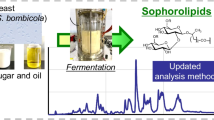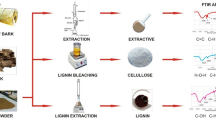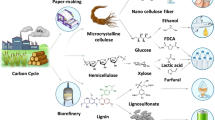Abstract
Depolymerized real lignin products are very complex mixtures. Comprehensive assessment of the decomposition efficiency and characterizing of depolymerized products still remain extremely challenging. In this study, based on depolymerization solution of commercially available sodium lignosulfonate under mild conditions, an improved method was well established for characterization of real lignin depolymerized products using GC–MS, which enabled the detection of main 37 lignin-based aromatic products. The effects of acid-catalyzed temperature, time and catalyst/lignin ratio on the depolymerization products were systematically investigated. The result revealed that ~ 25 wt% of lignosulfonate was depolymerized into lignin-derived aromatic products under optimized mild acid-catalyzed reaction conditions of 130 °C for 60 min with a catalyst/lignin ratio of 2.334. Most of the identified products were common commercial compounds, while the obtained bisphenols were potential compounds for new applications such as bio-based polymer building blocks. Preliminary studies also highlight that the depolymerization behavior seems to present selectivity to some extent during these specified acid-catalyzed reaction.






Similar content being viewed by others
References
Li MF, Sun SN, Xu F, Sun RC (2012) Organosolv fractionation of lignocelluloses for fuels, chemicals and materials: A biorefinery processing perspective. In: Baskar C, Baskar S, Dhillon RS (eds) Biomass conversion The interface of biotechnology, chemistry and materials science. Springer, Berlin, p 341
Bozell JJ, Petersen GR (2010) Technology development for the production of biobased products from biorefinery carbohydrates-the US Department of Energy’s “Top 10” revisited. Green Chem 12:539–554
Ennaert T, Van AJ, Dijkmans J, De CR, Schutyser W, Dusselier M, Verboekend D, Sels BF (2016) Potential and challenges of zeolite chemistry in the catalytic conversion of biomass. Chem Soc Rev 45:584–611
Ruppert AM, Weinberg K, Palkovits R (2012) Hydrogenolysis goes bio: from carbohydrates and sugar alcohols to platform chemicals. Angew Chem Int Ed 51:2564–2601
Smolarski N (2012) High-value opportunities for lignin: Unlocking its potential. Frost & Sullivan, pp 1–15
Da Costa Sousa L, Chundawat SP, Balan V, Dale BE (2009) Cradle-to-grave assessment of existing lignocellulose pretreatment technologies. Curr Opin Biotechnol 20:339–347
Pandey MP, Kim CS (2011) Lignin depolymerization and conversion: a review of thermochemical methods. Chem Eng Technol 34:29–41
Zakzeski J, Bruijnincx PC, Jongerius AL, Weckhuysen BM (2010) The catalytic valorization of lignin for the production of renewable chemicals. Chem Rev 110:3552–3599
Wang H, Tucker M, Ji Y (2013) (2013) Recent development in chemical depolymerization of lignin: a review. J Appl Chem 2013:1–9
Ennaert, T., Beeck, B. O. D., Vanneste, J. , Smit, A. T. & Sels, B. F. (2016). The importance of pretreatment and feedstock purity in the reductive splitting of (ligno)cellulose by metal supported usy zeolite. Green Chem 18: 2095–2105.-
Yu F, Thomas J, Smet M, Dehaen W, Sels BF (2016) Molecular design of sulfonated hyperbranched poly(arylene oxindole)s for efficient cellulose conversion to levulinic acid. Green Chem 18:1694–1705
Galkin MV, Samec JSM (2016) Lignin valorization through catalytic lignocellulose fractionation: a fundamental platform for the future biorefinery. Chemsuschem 9:1544–1558
Rinaldi R, Jastrzebski R, Clough MT, Kennema RJ, Bruijnincx M, Weckhuysen PCA (2016) Paving the way for lignin valorisation: recent advances in bioengineering, biorefining and catalysis. Angew Chem Int Ed 55:8164–8215
Arel HS (2017) The effect of lignosulfonates on concretes produced with cements of variable fineness and calcium aluminate content. Constr Build Mater 131:347–360
Li C, Zhao X, Wang A, Huber GW, Zhang T (2015) Catalytic transformation of lignin for the production of chemicals and fuels. Chem Rev 115:11559–11624
Bjørsvik HR, Minisci F (1999) Fine chemicals from lignosulfonates. 1. Synthesis of vanillin by oxidation of lignosulfonates. Org Process Res Dev 3:330–340
Bjørsvik HR, Norman K (1999) Fine chemicals from lignosulfonates. 2. Synthesis of veratric acid from acetovanillon. Org Process Res Dev 3:341–346
Pacek AW, Ding P, Garrett M, Sheldrake G, Nienow AW (2013) Catalytic conversion of sodium lignosulfonate to vanillin: engineering aspects. part 1. Effects of processing conditions on vanillin yield and selectivity. Ind Eng Chem Res 52:8361–8372
Han H, Wang Y, Li J, Xue F, Wang H, Zhang Y, Ge Q, Liu Y, Zhang M, Chen Y (2019) Production of oxygen-containing compounds catalytic from depolymerization of calcium lignosulphonate by submicron-scale MgAl solid base. Chem J Chin Univ 40:2322–2331
Khudoshin AG, Lunin VV, Bogdan VI (2011) Conversion of veratrole and sodium lignosulfonate in the suband supercritical water. Russ J Phys Chem B 5:1069–1075
Santos SG, Marques AP, Lima DLD, Evtuguin DV, Esteves VI (2011) Kinetics of eucalypt lignosulfonate oxidation to aromatic aldehydes by oxygen in alkaline medium. Ind Eng Chem Res 50:291–298
Fang H, Cui P, Qian C, Liu J, Liu T, Li D, Hu X (2018) Products separation and analysis of depolymerized lignosulfonate under mild acid-catalyzed conditions. Nat Prod Res Dev 30:176–1781
Qian Ch, Fang HX, Cui P, Cai F, Gao XY, He HL, Hu XP (2019) Rapid determination of lignosulfonate depolymerization products by advanced polymer chromatography. J Sep Sci 42:2289–2297
Cui P, Fang HX, Qian Ch, Chen MH (2020) Detection and Identification of Lignosulfonate Depolymerization Products Using UPLC-QTOF-MS and a Self-Built Database. Chromatographia 83:87–93
Wang YY, Ling LL, Jiang H (2016) Selective hydrogenation of lignin to chemical commodities by a biochar supported Ni-Mo2C catalyst obtained from biomass. Green Chem 18:4032–4041
Shu RY, Xu Y, Ma LL, Zhang Q, Wang TJ, Chen PR, Wu QY (2016) Hydrogenolysis process for lignosulfonate depolymerization using synergistic catalysts of noble metal and metal chloride. RSC Adv 6:88788–88796
Sun ZH, Fridrich B, Santi A, Elangovan S, Barta K (2018) Bright side of lignin depolymerization: toward new platform chemicals. Chem Rev 118:614–678
Zhao S, Abu-Omar MM (2015) Biobased epoxy nanocomposites derived from lignin-based monomers. Biomacromol 16:2025–2031
Zhou J, Zhang H, Deng J, Wu Y (2016) High glass-transition temperature acrylate polymers derived from biomasses, syringaldehyde, and vanillin. Macromol Chem Phys 217:2402–2408
Deuss PJ, Scott M, Tran F, Westwood NJ, de Vries JG, Barta K (2015) Aromatic monomers by in situ conversion of reactive intermediates in the acid-catalyzed depolymerization of lignin. J Am Chem Soc 137:7456–7467
Funding
This study was funded by Abroad Visiting & Research Program for Young Talents (No. gxfxZD2016236); Anhui Natural Science Foundation: KJHS2019B14; KJ2019A0613. Underground innovation and entrepreneurship training program of China (No. 201810375038).
Author information
Authors and Affiliations
Corresponding author
Ethics declarations
Conflict of interest
The authors declare that they have no conflict of interest.
Additional information
Publisher's Note
Springer Nature remains neutral with regard to jurisdictional claims in published maps and institutional affiliations.
Electronic supplementary material
Below is the link to the electronic supplementary material.
Rights and permissions
About this article
Cite this article
Hong-Xia, F., Peng, C. & Chen, Q. Behavior characterization of lignosulfonate depolymerization products under acid-catalyzed conditions using gas chromatography–mass spectrometry. Chromatographia 84, 109–116 (2021). https://doi.org/10.1007/s10337-020-03988-8
Received:
Revised:
Accepted:
Published:
Issue Date:
DOI: https://doi.org/10.1007/s10337-020-03988-8




